64 Cores of Rendering Madness: The AMD Threadripper Pro 3995WX Review
by Dr. Ian Cutress on February 9, 2021 9:00 AM EST- Posted in
- CPUs
- AMD
- Lenovo
- ThinkStation
- Threadripper Pro
- WRX80
- 3995WX
CPU Tests: Encoding
One of the interesting elements on modern processors is encoding performance. This covers two main areas: encryption/decryption for secure data transfer, and video transcoding from one video format to another.
In the encrypt/decrypt scenario, how data is transferred and by what mechanism is pertinent to on-the-fly encryption of sensitive data - a process by which more modern devices are leaning to for software security.
Video transcoding as a tool to adjust the quality, file size and resolution of a video file has boomed in recent years, such as providing the optimum video for devices before consumption, or for game streamers who are wanting to upload the output from their video camera in real-time. As we move into live 3D video, this task will only get more strenuous, and it turns out that the performance of certain algorithms is a function of the input/output of the content.
HandBrake 1.32: Link
Video transcoding (both encode and decode) is a hot topic in performance metrics as more and more content is being created. First consideration is the standard in which the video is encoded, which can be lossless or lossy, trade performance for file-size, trade quality for file-size, or all of the above can increase encoding rates to help accelerate decoding rates. Alongside Google's favorite codecs, VP9 and AV1, there are others that are prominent: H264, the older codec, is practically everywhere and is designed to be optimized for 1080p video, and HEVC (or H.265) that is aimed to provide the same quality as H264 but at a lower file-size (or better quality for the same size). HEVC is important as 4K is streamed over the air, meaning less bits need to be transferred for the same quality content. There are other codecs coming to market designed for specific use cases all the time.
Handbrake is a favored tool for transcoding, with the later versions using copious amounts of newer APIs to take advantage of co-processors, like GPUs. It is available on Windows via an interface or can be accessed through the command-line, with the latter making our testing easier, with a redirection operator for the console output.
We take the compiled version of this 16-minute YouTube video about Russian CPUs at 1080p30 h264 and convert into three different files: (1) 480p30 ‘Discord’, (2) 720p30 ‘YouTube’, and (3) 4K60 HEVC.
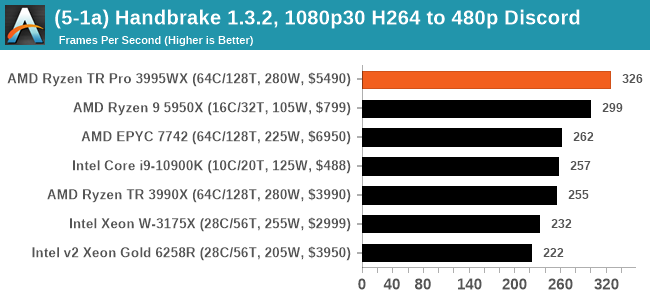
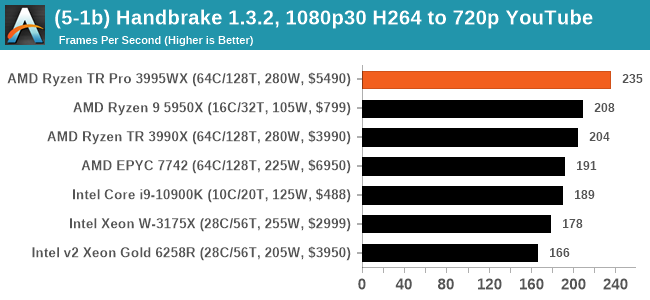
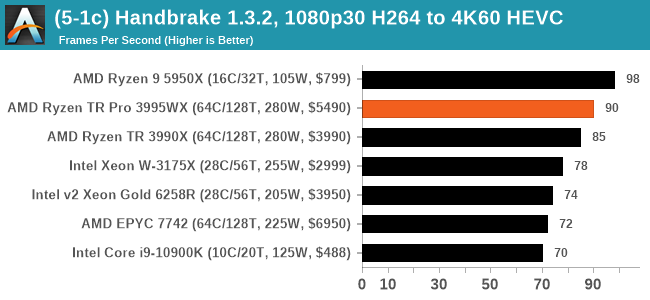
For the lower resolution modes, it would appear that the increased memory bandwidth plays a role for the 3995WX and 7742, although single core frequency also means a lot. Moving to the HEVC metrics, the Ryzen 9 takes a win here, but the 3995WX still goes above the 3990X.
7-Zip 1900: Link
The first compression benchmark tool we use is the open-source 7-zip, which typically offers good scaling across multiple cores. 7-zip is the compression tool most cited by readers as one they would rather see benchmarks on, and the program includes a built-in benchmark tool for both compression and decompression.
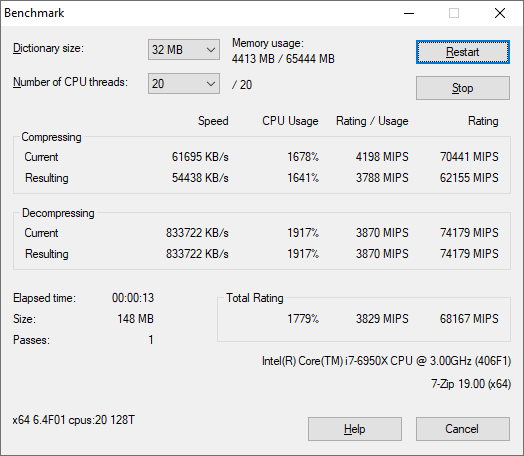
Example Test Run on an Intel 10-core i7-6950X
The tool can either be run from inside the software or through the command line. We take the latter route as it is easier to automate, obtain results, and put through our process. The command line flags available offer an option for repeated runs, and the output provides the average automatically through the console. We direct this output into a text file and regex the required values for compression, decompression, and a combined score.
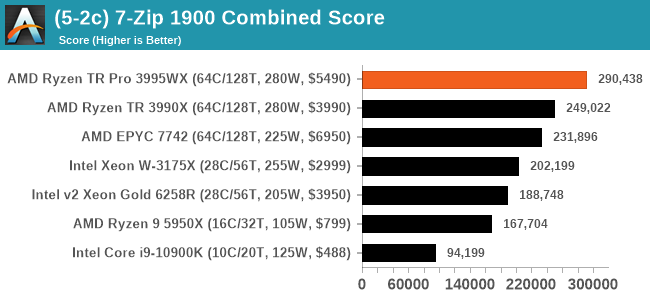
This is a 16.6% win for the TR Pro 3995WX.
AES Encoding
Algorithms using AES coding have spread far and wide as a ubiquitous tool for encryption. Again, this is another CPU limited test, and modern CPUs have special AES pathways to accelerate their performance. We often see scaling in both frequency and cores with this benchmark. We use the latest version of TrueCrypt and run its benchmark mode over 1GB of in-DRAM data. Results shown are the GB/s average of encryption and decryption.
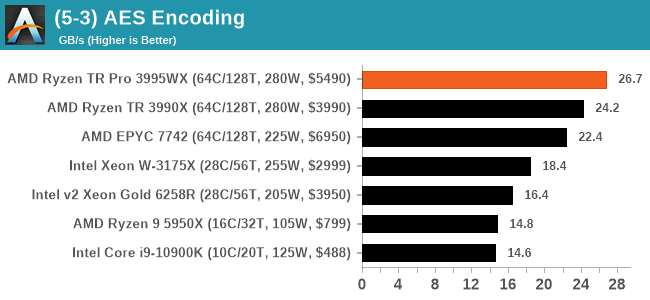
WinRAR 5.90: Link
For the 2020 test suite, we move to the latest version of WinRAR in our compression test. WinRAR in some quarters is more user friendly that 7-Zip, hence its inclusion. Rather than use a benchmark mode as we did with 7-Zip, here we take a set of files representative of a generic stack
- 33 video files , each 30 seconds, in 1.37 GB,
- 2834 smaller website files in 370 folders in 150 MB,
- 100 Beat Saber music tracks and input files, for 451 MB
This is a mixture of compressible and incompressible formats. The results shown are the time taken to encode the file. Due to DRAM caching, we run the test for 20 minutes times and take the average of the last five runs when the benchmark is in a steady state.
For automation, we use AHK’s internal timing tools from initiating the workload until the window closes signifying the end. This means the results are contained within AHK, with an average of the last 5 results being easy enough to calculate.
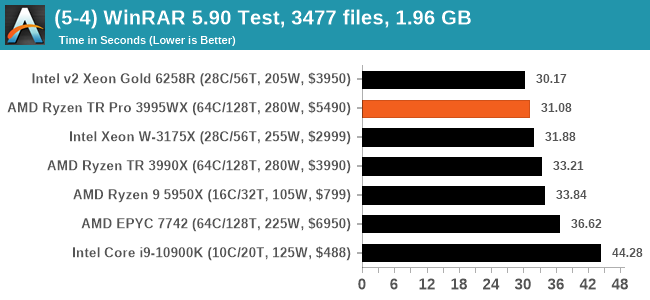
WinRAR is variable threaded, but the Xeon Gold takes the win here - even compared to the Xeon W-3175X. It's all relatively close at the top end.


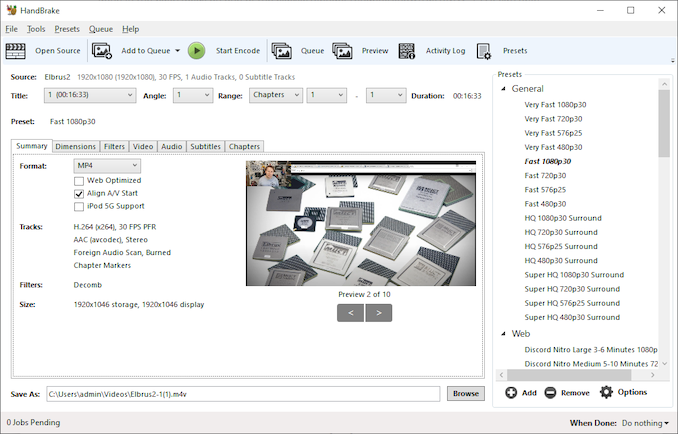
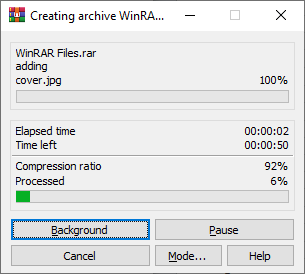








118 Comments
View All Comments
kwinz - Wednesday, February 10, 2021 - link
Really? CPUs are in high demand because GPU programming is hard? That's what you're going with?Gomez Addams - Wednesday, February 10, 2021 - link
Good heavens that was painful to read. Some of the worst writing have had to suffer through in a while. One tip : compute is a verb and not a noun, just as simulation is a noun and simulate is a verb. Just because marketing droids use a term does not mean it is correct.Spunjji - Thursday, February 11, 2021 - link
Sorry pal, language doesn't work that way. You may not *like* it, but that's the way it is!croc - Wednesday, February 10, 2021 - link
Are we now ignoring the elephant? EPYC was to launch in 2020. Actually, AMD said that Zen 3 would launch in 2020, but there's a weasel in them words... SOME of the Zen 3 cpu's DID launch, mostly looking like paper though. EPYC is sort-of launching as we speak, and Zen 3 Threadripper is a no-show.I have said this elsewhere, and I will say it here. It would appear that AMD's lack of fab experience is showing, as they seem to be having issues getting their designs to fab properly at 7nm. Low to no yields? And TSMC is having issues of their own with China buying up as much talent as it can, while threatening to just grab it all in a military takeover. TSMC should have already built an advanced fab somewhere in the west, out of China's reach. Europe? Canada? After Trump, I would say to avoid the US as much as it needs to avoid China.
Spunjji - Thursday, February 11, 2021 - link
AMD were hoping to get Milan into production in Q3 2020 and have it shipping to some customers by Q4, which they did. It's not available to OEMs yet, so hardly a fanfare moment, but not the "elephant" you're trying to paint it as either.Same goes for Zen 3, too - it absolutely wasn't a "paper launch" - but I see you're just here to push FUD rather than discuss *the article*.
Like, what's this "they seem to be having issues getting their designs to fab properly at 7nm" crap? Whose backside are you pulling that out of?
Amazing how many people seem to think these comment sections are the ideal place to grind their own personal political axes.
Oxford Guy - Thursday, February 11, 2021 - link
‘Amazing how many people seem to think these comment sections are the ideal place to grind their own personal political axes’You seem to think this is your personal website.
Qasar - Thursday, February 11, 2021 - link
as do you, point is ?Oxford Guy - Wednesday, March 10, 2021 - link
It’s not the tu quoque fallacy.tygrus - Thursday, February 11, 2021 - link
If total desktop sales were 20Million in 2020Q4 and if AMD sold 5M with about 0.95M being Zen3 so AMD could have been 19% of desktop CPU sales being Zen3. That's a good start and a lot better than <5% you may think happens for a paper launch. Notebook market adds another 50M/qtr (20% AMD?) and tablets (probably not AMD) on top of that so Zen3 sales would look like ~7% of AMD consumer CPU's sold that qtr.Not all sales & deliveries are publicised so server sales may have happened already for Zen3. The FAB capacity & yield were more than enough because it was the substrate & final assembly which limited supply.
ipkh - Sunday, February 28, 2021 - link
Really, they have Global Foundries to thank for this. Global Foundries miseead the market and decided to drop highend node production. This left TSMC as the only highend node company left standing (that does 3rd party fab). Global Foundries and Samsung could have had a much better roadmap working together with IBMs researchers. But they didn't and now we see how much it is costing the entire industry. AMD may be forced to use Samsung Foundries if TSMC production gets tied up.